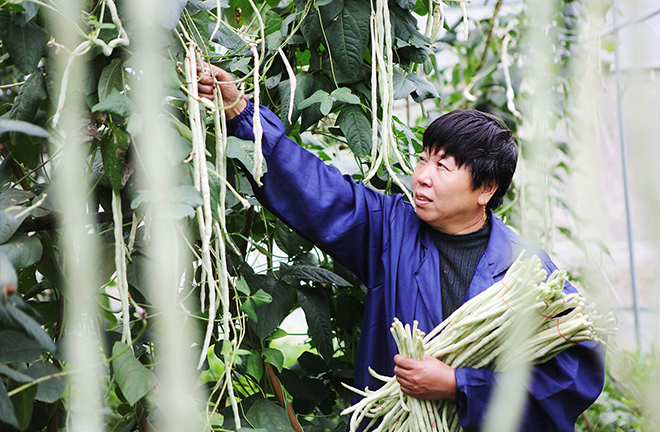Advancing rural revitalization across the board

A farmer picks legumes at a professional planting and breeding cooperative in Yichun, Jiangxi Province, on Nov. 20, 2022. Photo: CFP
According to the report to the 20th National Congress of the Communist Party of China (CPC), “the most challenging and arduous tasks we face in building a modern socialist China in all respects remain in our rural areas.” In the new era, issues relating to agriculture, rural areas, and rural people remain fundamental to China as they directly concern the country’s stability and the people’s wellbeing. These issues form the basis for advancing rural revitalization across the board and achieving common prosperity.
Notable progress
Since the start of the new era, China’s total grain output has stabilized at more than 1.3 trillion jin (650 million tons) for seven consecutive years. In 2021, the grain output reached a new high of 1,365.7 billion jin. The per capita share of grain reached 483 kilograms, far above the internationally recognized security line of 400 kilograms. The country’s self-sufficiency rates for grain were all above 95%, with the rates of wheat and rice exceeding 98%. The overall pass rate of agricultural products under regular surveillance over quality and safety remained above 97%.
Since the 18th CPC National Congress, the policy of strengthening agriculture, benefiting farmers, and enriching rural areas has been continuously reinforced, medical care and old-age insurance systems for rural residents have been further improved, new industries and new forms of business such as rural leisure tourism have flourished, and rural income structures have gradually been optimized.
Du Zhixiong, Party secretary of the Rural Development Institute at the Chinese Academy of Social Sciences, said that diversified income sources and an increased proportion of non-wage incomes imply optimization of income structures and a stable foundation for income increases, suggesting rural people’s lives are improving.
China has also seen significant improvements in rural infrastructure construction and living environments, alongside substantial progress in regard to rural people’s wellbeing. By the end of 2021, 87.3% of rural areas in China had access to public transportation, 99% of the areas were connected to broadband internet, 96.3% of rural domestic waste was disposed of in a centralized fashion, and the penetration rate of sanitary toilets reached 77.5%.
Luo Biliang, dean of the College of Economics and Management at South China Agricultural University, expounded on constantly increasing rural governance efficiency. Under the Party leadership, the rural governance system which integrates self-governance, the rule of law, and the rule of virtue has gradually improved, and the role and strength of Party organizations on the primary level have been continuously enhanced, in addition to steady cultural and ethical advancement.
Sustainable, green agricultural development has achieved remarkable results, the levels of resource protection, conservation, and utilization have been rising, and the agricultural production process has become cleaner. Huang Zuhui, a professor from the China Academy for Rural Development at Zhejiang University, said that China’s non-staple food supply has progressed significantly from “sufficient quantity” to “improved quality.” The coverage rate for green prevention and control of pests and diseases among main crops has reached 46%, and a cumulative number of 62,000 agricultural products have obtained green, organic labels and geographical indications, which symbolize high quality and a good reputation.
Huang concluded that whole-link upgrades, whole-value enhancements, and whole-industry integration have become new trends in high-quality agricultural development.
Building up strength in agriculture
The report to the 20th CPC National Congress proposed moving faster to “build up China’s strength in agriculture and steadily promote the revitalization of businesses, talent, culture, ecosystems, and organizations in the countryside.”
In terms of business revitalization, Huang suggested developing high-efficiency planting and breeding industries, and making innovations to farming systems.
Moreover, it is important to build a strong platform for developing featured industries with agricultural and rural resources, and tightly integrate agriculture with tourism, education, culture, health care, and other industries, Huang said. Efforts are also needed to fully leverage industrial and commercial capital, and form a pattern of complementary advantages and cooperative labor division within rural industrial chains.
Huang added that it is time to build a rural property rights system in line with the requirements of a market economy, support and guide rural people to revitalize natural and social resources—such as land, ecology, capital, technology, and labor—and to expand channels for employment and raising incomes.
The revitalization of rural talent must combine talent recruitment and training not only from the countryside, but also from all walks of life, said Qiu Huanguang, dean of the School of Agricultural Economics and Rural Development at Renmin University of China. To advance rural revitalization, Qiu underscored the urgency to cultivate agricultural production and management talent, including family farm operators and farmers’ cooperative leaders; talent for secondary and tertiary industries, such as entrepreneurs and innovators, e-commerce talent, and craftsmen; and agricultural technology talent, including high-tech leaders, science and technology promoters, as well as science and technology commissioners.
To revitalize agricultural culture, Huang highlighted the necessity to meet the intellectual and cultural needs of rural people while coordinating material and cultural-ethical advancement.
It is crucial to elevate the construction of rural culture to the institutional level, combine culture with the rule of virtue, and integrate it into the rural governance system to form a rule of virtue structure marked by multicultural integration and symbiosis. Huang said this will help form an efficient rural governance model combining self-governance, the rule of law, and the rule of virtue. It is also necessary to exploit cultural resources with rural features, drive rural economic development, and increase farmers’ incomes through the development of cultural industries, so as to realize the synergy of cultural-ethical and material prosperity, he added.
Edited by CHEN MIRONG
